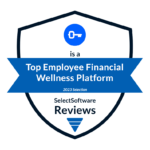In 2022, Americans’ financial health declined for the first time in five years. Today, seven out of 10 Americans are living paycheck to paycheck. Nearly half of Americans who earn $100,000+ a year live paycheck to paycheck, too.
Their financial challenges aren’t due to a lack of employer concern for their financial wellbeing. (In fact, 97% of employers feel at least somewhat responsible for employees’ financial wellness).
According to the latest Employee Benefit Research Institute (EBRI) Financial Wellbeing Employer Survey, there’s a costly gap in employer-sponsored financial benefits and many employers are heading in the wrong direction. For example, the EBRI survey found:
- Employers rate “retirement preparedness” as the top issue addressed by their financial wellness initiatives.
- Investments, retirement planning, and “basic financing and education, and consulting programs” are the top focus areas for employer financial wellness programs.
Without question, understanding how to manage and grow money to achieve retirement readiness is important. But when 70% of employees are unable to save month to month, that can’t be the only type of employee financial support offered if the goal is to improve their financial health.
Brightside customers Ben Roberge, Director, Financial & Retirement Programs at Unum, and Cathy Stewart, SHRM-SCP, Director, Retirement Programs at a Fortune 10 employer, session moderator Mindy Field, Minneapolis Business Leader at Mercer, and Brightside CEO and Co-Founder Tom Spann recently discussed topics like these in a Be Well Conference session called “How Financial Care Drives ROI for Frontline Workers.”
Find out what they had to say about how Brightside Financial Care differs from a 401(k) provider, and how benefits leaders can ensure they’re supporting all of their employees’ financial needs.
Retirement programs aren’t enough for financially sick employees
“When you think about people that need help the most, they cannot even [begin to] save for retirement. They need help managing their day-to-day finances before they can even save and plan for the long term. Financial Care is an integral piece of that holistic financial wellness,” said Field.
Spann added that the employees with the funds to invest or save for retirement generally aren’t the same people whose poor financial health costs employers in the form of expenses like turnover and healthcare.
“To drive ROI, you have to engage the financially sick people. They don’t view financial planning or financial education as a relevant product. They think they’ll be told they’re doing it wrong. They are not going to proactively engage,” said Spann.
Once employees understand that their Brightside Financial Care benefit offers real solutions for their financial emergencies, including loans that are tied to the paycheck and therefore offered at much lower interest rates than they could get elsewhere, and a free savings account that makes it easy to put a little money aside each pay period, they gain hope that they have a trusted resource who can help support their financial needs.
As employees are empowered and encouraged to take steps forward, they start to have more money. Then, employees begin to see that there is a way of paying off debt, feeling less stretched between paychecks, and improving their financial situation. Once they address their immediate money needs and see results, it’s far more likely that saving for retirement becomes more in reach.
What’s the big difference between Financial Care and a retirement benefit?
Most Fortune 500 employers offer employees a retirement savings plan, and that may include some type of financial education or planning. But that’s not enough. It’s important to offer benefits designed to serve the financial needs of all employees – particularly those who are struggling.
The reality is, the vast majority of Americans are not thinking about planning for years or even decades away. As such, most employees who come to Brightside need help meeting their day-to-day financial needs.
These employees are matched with a Brightside Financial Assistant who is specifically trained to offer non-judgmental, empathetic support, and who works to build trust and understand the employee’s unique needs, motivators, and barriers to financial health.
With that information, the Financial Assistant offers options that will improve the employee’s current financial situation and overall financial health. In some cases, this involves financial products from Brightside’s ecosystem of trusted, highly vetted financial partners. In more urgent cases, the Financial Assistant will do the legwork to connect the employee with resources such as free money, food, and opportunities to subsidize necessities like housing and utilities.
Employees who do come to Brightside for needs like investments are matched with a Financial Assistant who is also a certified financial planner (CFP). Brightside can also help employees navigate other benefits offered by their employer, based on their specific situation.
For example, Unum encourages employees to go to Brightside for any financial need, so Brightside can help them find the best solution. “We leverage it more as a front door to come to first, and then Brightside will point you to wherever you need to go,” said Roberge.
This approach has been successful at Unum because it is core to helping employees see results, find solutions, and feel hopeful that they can improve their financial situation. Unlike 401(k) vendors who have a business model that makes money from assets under management, Brightside’s mission is to improve the financial health of working families.
We do this by helping them take the financial actions and next steps that truly support their financial best interests.
“The key to behavioral economics is to make the right things easy to do, in a very complex system. That’s what we’re doing at Brightside,” said Spann.
To learn more about Brightside Financial Care, click here.





